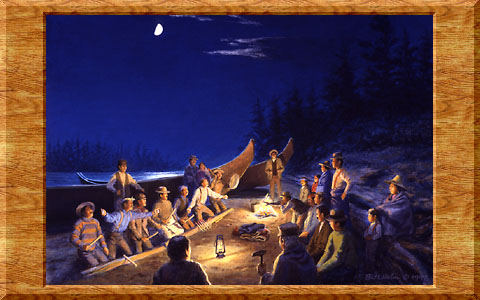
Original acrylic 18" x 24" by Bill Holm © 1997
Collection of Donn Charnley
On a still, moonlit night in the closing years of the nineteenth century, a group of Kwakwaka'wakw Indians, pausing on their trip home from the hop fields in the Puget Sound country, gamble on a beach in the San Juan Islands. Their big fifty foot travelling canoes are drawn up on the beach for the night. They are playing lehal or slahal (alaxwa in their language), the bone game, one of the most widespread and still popular gambling games of Native North America.
Accompanied by rousing songs and the percussion of sticks and drums, the game becomes almost a dance, as the bone handlers gesture and sway to the driving rhythm and the "pointer" and his associates on the guessing team try to confuse them with feints and false guesses. The pointer's object is to choose the location of the unmarked two (of the four) bone cylinders concealed in the hands of his opponents. His choice of the four possible locations -- both right, both left, both inside, both outside -- is indicated by hand signals, making play possible across linguistic boundaries. The many tribes gathered at the hop fields met often in lehal, where their exhilarant songs could be heard throughout the nights. This one is a friendly game, but stakes are always required, and blankets and money from hop-picking wages (wrapped in a scarf) are piled on the beach between the teams.
The ten counting sticks have shifted from team to team as the game progressed. Now, however, the pointer's side has only two left, and the outcome depends on his skill and gambling power to reverse the flow. He and his teammates concentrate their powers on the bone handlers, and he studies their eyes and gestures for any indication of the location of the white bones. With a combination of luck, skill, and supernatural power he makes his decision. Out goes the signal, outspread thumb and fingers, with a decisive slap of hand on arm, to indicate "both outside." His last chance has gone, as the bone holders triumphantly throw open their hands to show the unmarked bones "inside!" The game is over, the victors gather up their winnings and all retire for the night, to resume their leisurely 200 mile paddle home (with perhaps more lehal) in the morning.